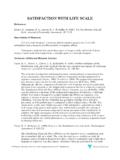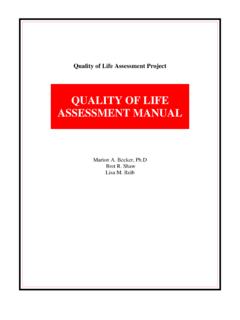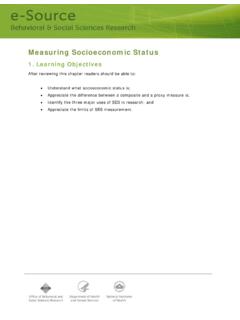Transcription of Constructing Indices and Scales - Bowling Green State ...
1 1 Constructing Indices and Scales Hsueh-Sheng Wu CFDR Workshop Series Summer 2012 2 Outline What are Scales and Indices ? Graphical presentation of relations between items and constructs for Scales and Indices Why do sociologists need Scales and Indices ? Similarities and differences between Scales and Indices Constructions of Scales and Indices Criteria for evaluating a composite measure Evaluation of Scales and Indices How to obtain the sum score of a scale or an index ? Conclusion 3 What Are Scales and Indices ? Scales and Indices are composite measures that use multiple items to collect information about a construct. These items are then used to rank individuals. Examples of Scales : Depression Scales Anxiety scale Mastery scale Examples of Indices : Socio-Economic Status (SES) index Consumer price index Stock market index Body mass index Graphical Presentation of Relations between Items and Constructs for Scales and Indices scale : 4 index : Depression Feeling sad Sleepless Suicidal Ideation e e e Social Economic Status Education Income Occupation e 5 Why Do Sociologists Need Scales and Indices ?
2 Most social phenomenon of interest are multi-dimensional constructs and cannot be measured by a single question, for example: Well-being Violence When a single question is used, the information may not be very reliable because people may have different responses to a particular word or idea in the question. The variation of one question may not be enough to differentiate individuals. Scales and Indices allow researchers to focus on large theoretical constructs rather than individual empirical indicator. 6 Similarities and Differences between Scales and Indices Similarities: Both try to measure one construct. Both recognize that this construct has multiple-dimensional attributes. Both use multiple items to capture these attributes. Both can apply various measurement levels ( , nominal, ordinal, interval, and ratio) to the items. Both are composite measures as they both aggregate the information from multiple items.
3 Both use the weighted sum of the items to assign a score to individuals. The score that an individual has on an index or a scale indicates his/her position relative to those of other people. Differences: scale consists of effect indicator, but index includes causal indicators Scales are always used to give scores at individual level. However, Indices could be used to give scores at both individual and aggregate levels. They differ in how the items are aggregated. Many discussions on the reliability and validity of the Scales , but few discussions on those of Indices . Construction of Scales Devilish, Robert (2011) scale Development: Theory and Applications clearly what it is you want to measure an item pool the format for measurement the initial item pool reviewed by experts inclusion of validation items items to a development sample the items scale length 7 8 Construction of Indices Babbie, E (2010) suggested the following steps of Constructing an index 1.
4 Selecting possible items Decide how general or specific your variable will be Select items with high face validity Choose items that measure one dimension of the construct Consider the amount of variance that each item provides 2. Examining their empirical relations Examine the empirical relations among the items you wish to include in the index 3. Scoring the index you then assign scores for particular responses, thereby making a composite variable out of your several items 4. Validating it item analysis The association between this index and other related measures. Concepts of Reliability and Validity Reliability: Whether a particular technique, applied repeatedly to the same object, yields the same result each time Test-retest reliability Alternate-forms reliability (split-halves reliability) Inter-observer reliability Inter-item reliability (internal consistency) Validity: The extent to which an empirical measure adequately reflects the real meaning of the concept under consideration Face validity Content validity Construct validity (convergent validity and discriminant validity) Criterion validity (concurrent validity and predictive validity) 9 Reliability Test-retest reliability: Apply the test at two different time points.
5 The degree to which the two measurements are related to each other is called test-retest reliability Example: Take a test of math ability and then retake the same test two months later. If receiving a similar score both times, the reliability of this test is high. Possible problems: Test-retest reliability holds only when the phenomenon do not change between two points in time. Respondents may get a better score when taking the same test the second time, which reduce the test-retest reliability 10 Reliability (cont.) Alternate-forms reliability: Compare respondents answers to slightly different versions of survey questions. The degree to which the two measurements are related to each other is called alternative-form reliability. Possible problem: How to make sure these two alternate-forms are equivalent? 11 Reliability (cont.) Split-halves reliability Similar to the concept of alternate-forms reliability Randomly divide survey sample into two.
6 These two halves of the sample answer two forms of the questions. If the responses of the two halves of the sample are about the same, the measure s reliability is established Possible problem: What if these two halves are not equivalent? 12 Reliability (cont.) Inter-observer reliability When more than one observer to rate the same people, events, or places If observers are using the same instrument to rate the same thing, their ratings should be very similar. If they are similar, we can have much confidence that the ratings reflect the phenomenon being assessed than the orientations of the observers Possible problem: The reliability is established for observers, not for the measurement items. Thus, inter-observer reliability cannot be generalized to studies with different observers. 13 Reliability (cont.) Inter-item reliability Apply only when you have multiple items to measure a single concept. The stronger the association among the individual items, the higher the reliability of the measures.
7 In Statistics, we use Cronbach s Alpha to measure inter-item reliability. 14 Validity The extent to which an empirical measure adequately reflects the real meaning of the concept under consideration Face validity Content validity Criterion validity (concurrent and predictive validity) Construct validity (convergent and discriminant validity) 15 Face Validity The quality of an indicator that makes it seem a reasonable measure of some variable ( on its face ) Example: frequency of church attendance an indicator of a person s religiosity 16 Content Validity The degree to which a measure covers the full range of the concept s meaning Example: Attitudes toward police department contain different domains, for example, expectation, past experience, others experience, and mass media 17 Criterion Validity The degree to which a measure relates to some external criterion Example: Using a blood-alcohol concentration or a urine test as the criterion for validating a self-report measure of drinking 18 Concurrent Validity A measure yields scores that are closely related to scores on a criterion measured at the same time Example: Comparing a test of sales ability to the person s sales performance 19 Predictive Validity The ability of a measure to predict score on a criterion measured in the future Example: SAT scores can predict the college students GPA (SAT scores would be a valid indicator of a college student s success) 20 Construct Validity The degree to which a measure relates to other variables as expected within a system of theoretical relationships Example.
8 If we believe that marital satisfaction is related to marital fidelity, the response to the measure of marital satisfaction and the response to the measure of marital fidelity should act in the expected direction ( , more satisfied couples also less likely to cheat each other) 21 Convergent vs. Discriminant Validity Convergent validity -- one measure of a concept is associated with different types of measures of the same concept Discriminant validity -- one measure of a concept is not associated with measures of different concepts 22 Reliability and Validity of Scales and Indices 23 ScalesIndicesReliabilityTest-retest reliabilityX?Alternate-forms reliability (split-halves reliability)X?Inter-observer reliabilityX?Inter-item reliabilityX?ValidityFace validityXXContent validityXXCriterion validityconcurrent validityXXpredictive validityXXConstruct validityconvergent validityXXdiscriminant validityXXTable 1. The reliability and validity of Scales and indicesHow to obtain the sum score of a scale or an index Common way Assume that each item have the equal weight, and simply sum each item together Use factor analysis 24 Variable NameVariable Descriptiongrnconconcerned about environmentgrndemoprotested for envir issuegrneconworry too much about envir, too little econgrneffmeenvironment effect everyday lifegrnexaggenvironmental threats exaggeratedTable 1.
9 Variable about environment in General Socail Survey, 201025 How to obtain the sum score of a scale or an index (Cont.) grnexagg grneffme grnecon grndemo grncon Variable Factor1 Factor2 Factor3 Uniqueness Factor loadings (pattern matrix) and unique variances LR test: independent vs. saturated: chi2(10) = Prob>chi2 = Factor5 . Factor4 Factor3 Factor2 Factor1 Factor Eigenvalue Difference Proportion Cumulative Rotation: (unrotated) Number of params = 10 Method: principal factors Retained factors = 3 Factor analysis/correlation Number of obs = 1287(obs=1287).
10 Factor grncon grndemo grnecon grneffme grnexagg26 How to obtain the sum score of a scale or an index (Cont.) Factor1 = *grncon + *grndemo + *grnecon + *grneffme + *grnexagg Factor2 = *grncon + *grndemo + *grnecon + *grneffme + *grnexagg Factor3 = *grncon + *grndemo + *grnecon + *grneffme + *grnexagg Score1 = *educ + *realrinc + *prestg80 Score2 = *educ + *realrinc + *prestg81 Score3 = *educ + *realrinc + *prestg82 27 prestg80 0 realrinc 0 educ 0 Variable Comp1 Comp2 Comp3 Unexplained Principal components (eigenvectors) Comp3.



















